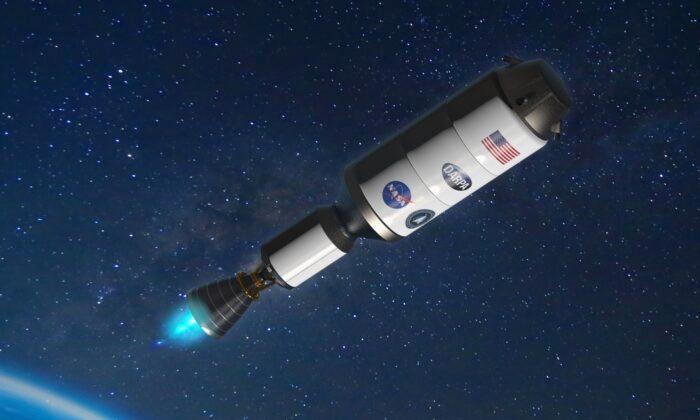A top NASA official revealed this week that the agency is teaming up with the Department of Defense (DOD) to test a spacecraft engine powered with nuclear fission by 2027, an effort that is part of a long-term NASA plan to send crewed missions to Mars.
“With the help of this new technology, astronauts could journey to and from deep space faster than ever—a major capability to prepare for crewed missions to Mars,” Nelson said.
The project, which has been dubbed the Demonstration Rocket for Agile Cislunar Operations or “DRACO,” will aim at reducing transit time and risks for astronauts by using a nuclear thermal rocket.
Another benefit would be increased science payload capacity and higher power for instrumentation and communication, officials say.
“In a nuclear thermal rocket engine, a fission reactor is used to generate extremely high temperatures. The engine transfers the heat produced by the reactor to a liquid propellant, which is expanded and exhausted through a nozzle to propel the spacecraft,” according to the agency, which also noted that nuclear thermal rockets can be “three or more times more efficient than conventional chemical propulsion.”
NASA officials view nuclear thermal propulsion as crucial for sending humans beyond the moon and deeper into space. A trip to Mars from Earth using the technology could take roughly four months instead of some nine months with a conventional, chemically powered engine, engineers say.
“If we have swifter trips for humans, they are safer trips,” NASA deputy administrator and former astronaut Pam Melroy said during a news conference on Tuesday.
The planned 2027 demonstration, part of an existing DARPA research program that NASA is now joining, could inform the ambitions of the U.S. Space Force, which has envisioned deploying nuclear reactor-powered spacecraft capable of moving other satellites orbiting near the moon, DARPA and NASA officials said.
In 2021, DARPA awarded funds to General Atomics, Lockheed Martin, and Jeff Bezos’ space company, Blue Origin, to study designs of nuclear reactors and spacecraft. By around March, the agency will pick a company to build the nuclear spacecraft for the 2027 demonstration, program manager Tabitha Dodson said in an interview.
The joint NASA-DARPA effort’s budget is $110 million for fiscal year 2023 and is expected to be hundreds of millions of dollars more through 2027.
“DARPA and NASA have a long history of fruitful collaboration in advancing technologies for our respective goals, from the Saturn V rocket that took humans to the Moon for the first time to robotic servicing and refueling of satellites,” said DARPA director Dr. Stefanie Tompkins.
“The space domain is critical to modern commerce, scientific discovery, and national security,” she continued. “The ability to accomplish leap-ahead advances in space technology through the DRACO nuclear thermal rocket program will be essential for more efficiently and quickly transporting material to the Moon and eventually, people to Mars.”
The space agency has researched the concept of nuclear thermal propulsion for more than half a century.
“Funding for NERVA, however, decreased in the late 1960s,” the agency said, noting that it resulted in the program eventually being canceled in 1973 before any flight tests took place.





